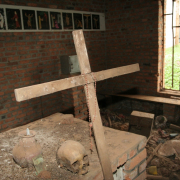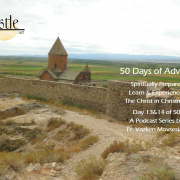Mystery Behind the Curtain: Archbishop Tiran, 3
Armodoxy for Today: Mystery behind the Curtain
So there I was at the altar of the Holy Cross Armenian Church in New York with the most knowledgeable man in the Armenian Church. With the Lenten curtain draped behind us, we stood in this narrow space looking up at the altar. Archbishop Tiran Nersoyan, now in his twilight years, had invited me out to New York, to offer a position as editor of the St. Nersess Journal. We spent three days together, having coffee, talking, more coffee and every so often breaking for meals.
At this moment we were at the altar, and I was talking to him about “mystery,” a word that seems to be at the center of religiosity. Things we cannot answer or describe we designation into the category of mystery. Years earlier, when I was writing my thesis in collage, I had the pleasure and honor of interviewing Archbishop Tiran about the Armenian Genocide, and how in the face of such a horrendous and monumental atrocity such as genocide, we, Armenians, can maintain a belief in a good and all-powerful God? That is, if He is good and all powerful, why would he allow genocide to take place. His answer, to this day, I have not forgotten. He replied with a snicker, as if to say, how can you be so naïve. “If you live in the jungle, and you are attacked by a tiger, why would you blame God?”
How simple is that? If we live in a jungle we have to comply with and accept the rules of the jungle. Throughout my years as a parish priest I have stood with families dealing with the worst of the worst news and prognoses. It is there, at those moments, that theology has to come alive – it has to make sense in life. Archbishop Tiran was giving a practical response to the problem of evil. Why is there cancer? Because we’ve polluted our environment and our bodies. Why are there accidents? Because people are careless and imperfect. Why is there theft? Why violence? Why evil? We live with wants, jealousies, desires, and the freedom to act on our feelings of pride, envy, anger, sloth, covetousness, gluttony and lust. Yes, the fabulous seven and all their forms!
There we were, in front of the altar. He had asked me about the 12 candles and I got that one wrong. How could it have been the 12 signs of the zodiac? It didn’t figure, but then, I was there to discover “mystery” and that it was.
“God gives us a mind. He gives us reason,” said the archbishop. “We cannot put reason to one side when we can’t answer a question and call it mystery.” Saying that, he tried me again. “Why does the church have four walls?”
I wasn’t going to get this wrong. There couldn’t be another zodiac-type answer. “The four evangelists!,” I exclaimed boldly. “Matthew, Mark, Luke and John, these are the four walls that encase the church.” I had this; I knew it. But the old archbishop laughed one more time.
“The church has four walls to keep the roof up,” he said with a smile that let us both know that the master still the upper hand over the students.
Mystery is important to acknowledge. But life has real parameters. Just as it is necessary to keep a roof atop a building with four walls, we need to answer many of the dilemmas we create and or encounter. Those three days in New York, with Archbishop Tiran were precious and gave me clarity and focus. As for the St. Nersess Journal, it didn’t happen. Archbishop Tiran died a few months later before he had finalized his wishes. It was, in a sense, a blessing that it didn’t happen. As a result, the year after, we established and published, “Window, View of the Armenian Church,” a journal of contemporary Armenian Church thought. From 1990 to 1995 we brought a light through that window which will be the story of another day.
We end with the words of a layman, and a scientist of the genius type, no less, Albert Einstein, regarding mystery. The most beautiful thing that we can experience is the mysterious. It is the source of all true art and all science. He to whom this emotion is a stranger, who can no longer pause to wonder and stand rapt in awe, is as good as dead; his eyes are closed. The insight into the mystery of life, coupled though it be with fear, has also given rise to religion. To know what is impenetrable to us really exists, manifesting itself as the highest wisdom and the most radiant beauty, which our dull faculties can comprehend only in their most primitive forms – this knowledge, this feeling is at the center of true religiousness.
This is the third and final installment of Mystery: My three days with Archbishop Tiran
Listen to previous days:
#1 – Christian Courage – Archbishop Tiran – epostle
#2 – Mystery Too Deep – Apb. Tiran, more – epostle

 2014 Gregory Beylerian
2014 Gregory Beylerian
 2023 Epostle
2023 Epostle
 2025 Epostle
2025 Epostle 2025 Epostle
2025 Epostle 2014 Fr. Vazken
2014 Fr. Vazken

 2014 Greg Beylerian
2014 Greg Beylerian 2023 Fr. Vazken Movsesian
2023 Fr. Vazken Movsesian
Leave a Reply
Want to join the discussion?Feel free to contribute!